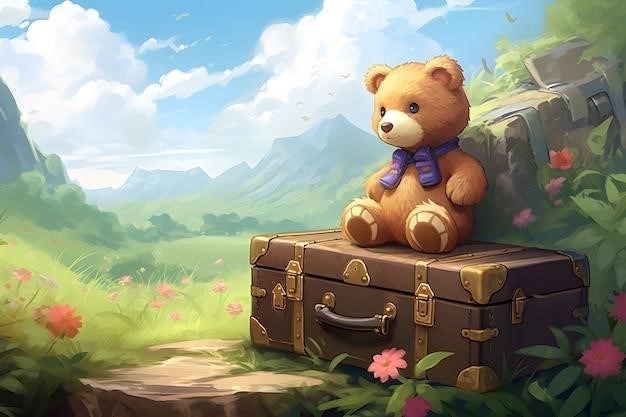The Story of Goldilocks and the Three Bears
The tale of Goldilocks and the Three Bears is a classic children’s story that has been enjoyed by generations. It tells the story of a young girl, Goldilocks, who enters the home of three bears while they are away. She tries their porridge, sits in their chairs, and sleeps in their beds, finding one of each that is “just right” for her. The story has been adapted and re-imagined countless times, and its popularity continues to this day.
Introduction
The story of Goldilocks and the Three Bears is a beloved children’s tale that has captivated audiences for generations. It is a story that transcends cultures and languages, resonating with young and old alike. The narrative revolves around a curious and mischievous young girl named Goldilocks who stumbles upon the home of three bears while they are out for a walk. Driven by her insatiable curiosity, Goldilocks enters the bears’ house and embarks on a series of adventures, exploring their belongings and ultimately creating a chaotic scene that leads to an unforgettable encounter with the bears themselves.
The story’s enduring appeal lies in its simplicity, its relatable characters, and its underlying moral lessons. It is a story that teaches children about the importance of respecting others’ property, the consequences of their actions, and the need to consider the feelings of others. Through its captivating narrative and timeless themes, “Goldilocks and the Three Bears” continues to entertain and educate children around the world, reminding them that even the smallest of actions can have significant repercussions.
The Three Bears
At the heart of the story reside the three bears—Papa Bear, Mama Bear, and Baby Bear. Each bear represents a distinct personality and embodies different aspects of family life. Papa Bear, the patriarch of the family, is portrayed as large and strong, reflecting the traditional role of the father as the provider and protector. Mama Bear, on the other hand, embodies nurturing and care, representing the maternal figure who ensures the well-being of her family. Baby Bear, the youngest of the trio, is depicted as small and playful, symbolizing the innocence and joy of childhood.
The three bears are not just characters in a story; they are symbolic representations of family dynamics and the different roles that each member plays. They highlight the importance of family bonds, the need for individual expression within a family unit, and the unique challenges and rewards that come with being a parent. Through their distinct personalities and actions, the three bears offer a glimpse into the complexities of family life and the delicate balance between individual needs and collective well-being.
Goldilocks’s Arrival
The story unfolds with Goldilocks, a curious and adventurous young girl, venturing into the forest. She stumbles upon a charming little cottage, its windows glowing invitingly. Driven by her innate curiosity and a touch of impulsiveness, Goldilocks approaches the cottage, her eyes sparkling with anticipation. The door is ajar, beckoning her closer, and without a second thought, Goldilocks steps inside, her footsteps echoing softly in the stillness of the empty house.
The cottage, as Goldilocks soon discovers, belongs to the three bears. It is a place of warmth and comfort, filled with the scent of home-cooked meals and the lingering aroma of freshly baked bread. The tables are set, chairs are neatly arranged, and beds are made with meticulous care. Goldilocks, drawn in by the inviting atmosphere, finds herself exploring the home, her innocent curiosity leading her from room to room, unaware of the consequences that await her.
The Porridge
As Goldilocks explores the three bears’ home, her stomach begins to rumble with hunger. She discovers a table set with three bowls of steaming porridge, each one a different size. The first bowl, belonging to Papa Bear, is too hot for Goldilocks’s delicate taste. The second bowl, belonging to Mama Bear, is too cold, leaving her with a disappointed frown. Finally, she reaches the third bowl, belonging to Baby Bear, and her eyes light up. This one is just right, neither too hot nor too cold.
Unable to resist, Goldilocks scoops up a spoonful of Baby Bear’s porridge, savoring its delicious warmth and flavor. She continues to eat, her hunger finally satiated, until the bowl is empty. The porridge, once a symbol of the bears’ home and family, is now a testament to Goldilocks’s impulsive actions. This act of transgression sets the stage for the rest of the story, where Goldilocks’s disregard for the bears’ belongings leads to a series of unintended consequences.
The Chairs
After satisfying her hunger, Goldilocks’s curiosity leads her to a cozy living room. There, she spots three chairs, each one uniquely crafted for its owner. The first chair, a massive and sturdy armchair, is Papa Bear’s. Goldilocks attempts to sit, but finds it too hard and uncomfortable. She tries the second chair, a smaller and more delicate chair belonging to Mama Bear. This one is too soft and sinks beneath her weight, leaving her feeling unsettled.
Finally, Goldilocks discovers Baby Bear’s chair, a tiny and inviting seat. She sits down gently, feeling its perfect balance of comfort and support. The chair seems to fit her just right, and she settles in for a moment of relaxation. The chairs, like the porridge, are a reflection of the bears’ individuality, each one tailored to their specific needs and preferences. Goldilocks’s exploration of these chairs highlights her desire to find her own “just right” in a world that seems too big or too small for her.
The Beds
As the day wears on and fatigue sets in, Goldilocks finds herself drawn to the three bedrooms, each with a bed waiting to be tested. The first bed, a massive four-poster monstrosity, is Papa Bear’s. Goldilocks climbs onto the bed, but its sheer size overwhelms her. It’s too hard and too high, leaving her feeling lost and uncomfortable. Next, she tries Mama Bear’s bed, a smaller and softer bed, hoping for a more comfortable experience. However, it is still too big for her, leaving her feeling like she’s sinking into a bottomless pit.
Finally, Goldilocks stumbles upon Baby Bear’s bed, a tiny and inviting haven. She carefully climbs onto the bed, feeling its soft and cozy embrace. The bed feels just right, perfectly suited to her size and needs. She snuggles into the pillows, feeling a sense of warmth and security. Goldilocks falls into a deep and restful sleep, oblivious to the return of the bears. The beds, much like the porridge and chairs, represent a spectrum of sizes and comfort, mirroring the individual preferences of the bears. Goldilocks, through her exploration, finds a place where she truly belongs, even if it is momentarily, in the seemingly perfect world of Baby Bear.
The Bears Return
The afternoon sun begins to dip below the horizon, casting long shadows across the forest. The three bears, having enjoyed their leisurely stroll, make their way back home, their stomachs grumbling in anticipation of their dinner. As they approach their cozy cottage, they notice something amiss. The door is ajar, and a faint scent of porridge fills the air. A sense of unease washes over them as they push open the door, their suspicions growing with each step they take inside. The sight that greets them is both surprising and unsettling⁚ their porridge bowls are empty, their chairs are broken, and their beds are disheveled. In the middle of Baby Bear’s bed, nestled in the covers, lies a young girl, fast asleep.
A collective gasp escapes their lips as they realize that someone has been in their home. Papa Bear, with his booming voice, roars, “Who’s been sleeping in my bed?” Mama Bear, with a gentler tone, asks, “Who’s been sitting in my chair?” Baby Bear, his voice trembling with anger, cries, “Who’s been eating my porridge?” The sound of their voices awakens Goldilocks, who, startled by the sight of the three bears, jumps out of bed and rushes to the window. She throws it open, scrambling out and disappearing into the forest, leaving the three bears to ponder the strange events of the day.
Goldilocks’s Escape
The sudden appearance of the three bears sends a jolt of fear through Goldilocks. She scrambles out of bed, her heart pounding in her chest. Her eyes dart around the room, searching for a way out. The window, with its view of the lush forest, offers a glimmer of hope. With a burst of adrenaline, she throws open the window, the cool evening air rushing in. She hesitates for a moment, her gaze lingering on the three bears, their expressions a mixture of anger and bewilderment. But the fear of being caught, of facing their wrath, pushes her forward.
She climbs onto the window sill, her small legs dangling over the edge. The ground below seems impossibly far away, but the thought of the bears’ impending fury fuels her courage. With a deep breath, she leaps, her body tumbling through the air. She lands with a thud on the soft forest floor, her breath catching in her throat. She scrambles to her feet, her heart still racing. Without looking back, she runs, the sound of her footsteps echoing through the trees. The memory of the three bears, their angry faces, their accusing voices, propels her forward, urging her to escape their wrath. She runs until her lungs burn and her legs ache, until the sound of the bears’ voices fades into the distance. Finally, she stops, her body trembling, her mind racing. She has escaped the bears, but the consequences of her actions will linger in her memory for years to come.

Variations of the Story
While the core elements of the story – Goldilocks, the three bears, the porridge, chairs, and beds – remain consistent, variations have emerged over time, reflecting cultural shifts and interpretations. In some versions, Goldilocks is not a mischievous child, but a poor and hungry girl seeking shelter and food. The bears themselves can also be portrayed differently, sometimes as gentle giants, other times as more menacing figures. The original story, which dates back to the 19th century, often featured an older woman instead of Goldilocks, adding a layer of intrigue and mystery.
The ending of the story has also been subject to interpretation. While the classic version depicts Goldilocks escaping the bears, other variations see her being punished for her actions, highlighting the importance of respecting others’ property and privacy. Some versions even introduce moral lessons, emphasizing the consequences of greed and impulsivity. These variations demonstrate the enduring appeal of the story, its ability to adapt and resonate with different audiences and interpretations;
Themes and Moral Lessons
At its core, “Goldilocks and the Three Bears” explores themes of respect for others’ property and the importance of considering individual preferences. The story highlights the consequences of uninvited intrusion and the discomfort that can arise when someone disregards boundaries. Goldilocks’s actions, from consuming the bears’ porridge to disrupting their home, serve as a cautionary tale about the importance of respecting others’ spaces and belongings.
Furthermore, the story touches upon the concept of “just right,” suggesting that finding the perfect fit, whether in food, furniture, or even relationships, is crucial for satisfaction and well-being. Each bear has their own preferred size and temperature for their belongings, emphasizing the importance of individuality and recognizing that what suits one person may not suit another. Goldilocks’s search for what is “just right” for her highlights the need to find comfort and satisfaction in a world that caters to diverse needs and preferences.
Goldilocks and the Three Bears in Popular Culture
The enduring appeal of “Goldilocks and the Three Bears” has transcended the realm of children’s literature, permeating popular culture in various forms. From television adaptations to theatrical productions, the story has been reinterpreted and reimagined countless times, captivating audiences of all ages. The iconic characters, particularly Goldilocks, have become synonymous with curiosity, mischief, and the search for what is “just right.”
The story’s themes have resonated with creators across various media. The “Goldilocks Principle” has been applied in fields ranging from economics to psychology, illustrating the concept of finding an optimal balance or “sweet spot.” The tale has also inspired numerous parodies and spin-offs, showcasing its enduring relevance and adaptability to contemporary contexts. Whether in the form of animated films, musical performances, or even video games, “Goldilocks and the Three Bears” continues to captivate and entertain, demonstrating its enduring place in the cultural landscape.
Goldilocks and the Three Bears in Education
The story of “Goldilocks and the Three Bears” has proven to be a valuable tool in educational settings, engaging young learners and fostering their development in various areas. The simple yet captivating narrative provides a platform for exploring diverse educational concepts, from language and literacy to social-emotional learning.
The story’s repetition and predictable structure make it ideal for early literacy development. Children can readily follow along with the text, identifying key vocabulary and learning about sentence structure. The tale also offers opportunities for discussions about character traits, feelings, and consequences, encouraging children to develop their critical thinking and empathy skills. Teachers often utilize “Goldilocks and the Three Bears” to introduce concepts of “too big,” “too small,” and “just right,” laying the foundation for mathematical understanding and problem-solving abilities.
The enduring appeal of “Goldilocks and the Three Bears” lies in its timeless themes and relatable characters. The story’s exploration of boundaries, consequences, and the search for what fits just right continues to resonate with audiences of all ages. Its adaptability across various mediums, from traditional storytelling to modern adaptations, ensures its continued relevance and presence in popular culture. Whether enjoyed as a bedtime story, a theatrical performance, or a digital adaptation, the tale of Goldilocks and the Three Bears remains a cherished classic that sparks imagination, promotes learning, and fosters a connection between generations.


